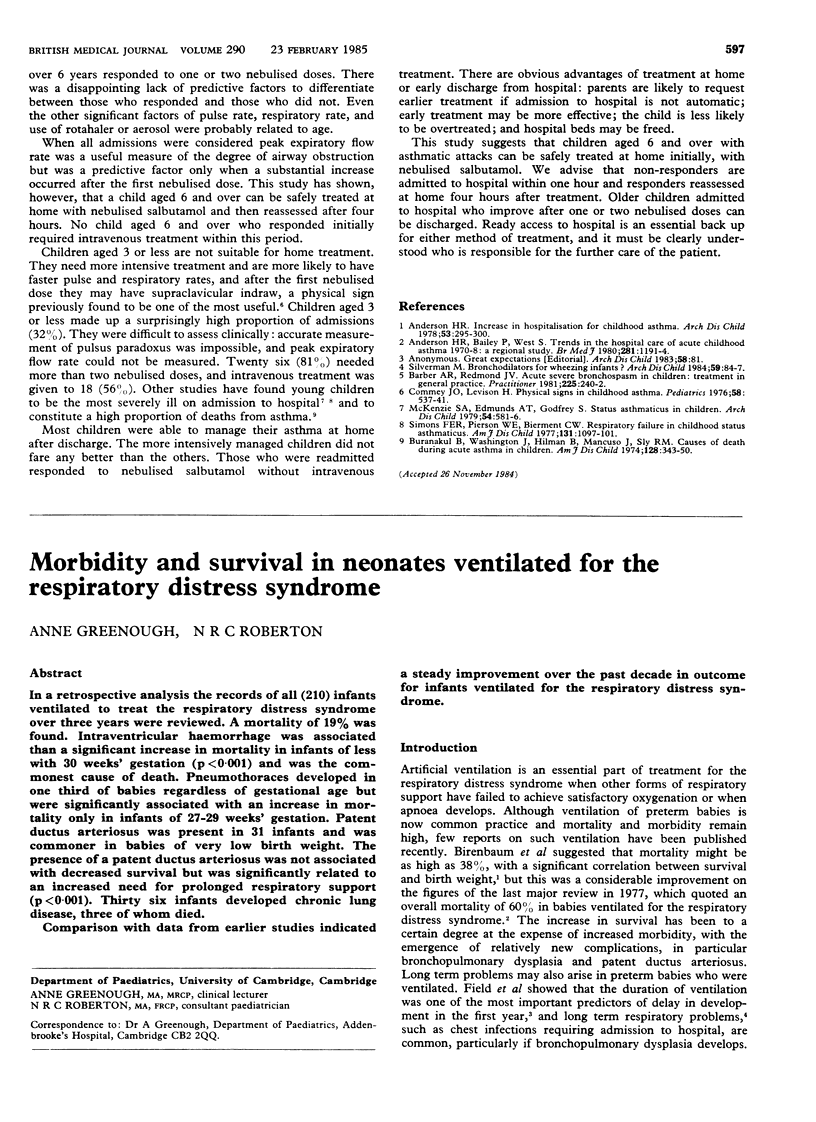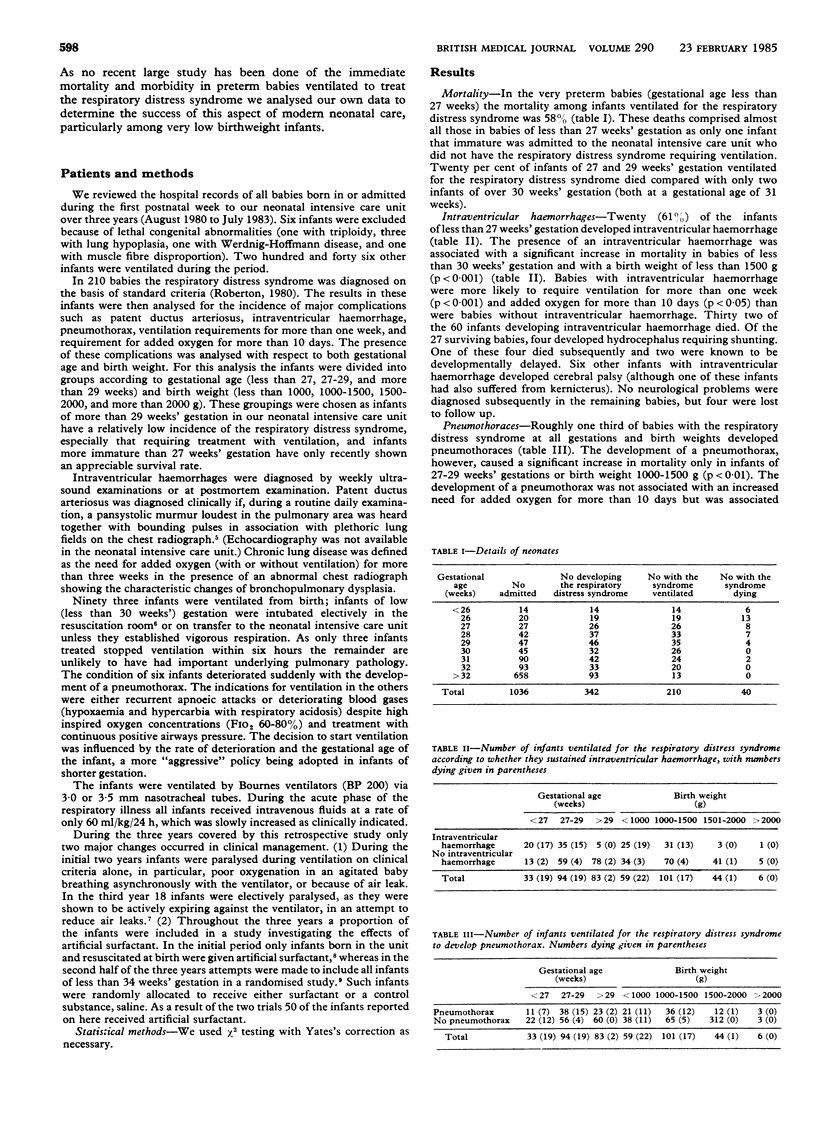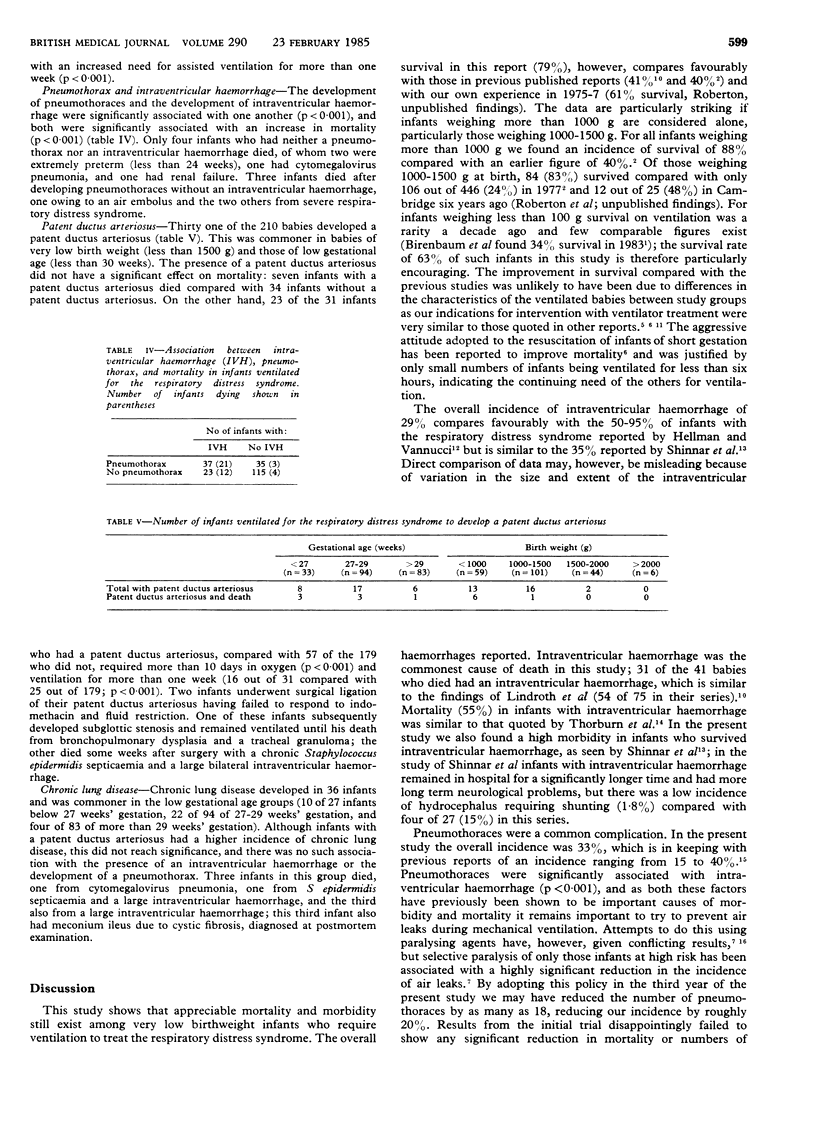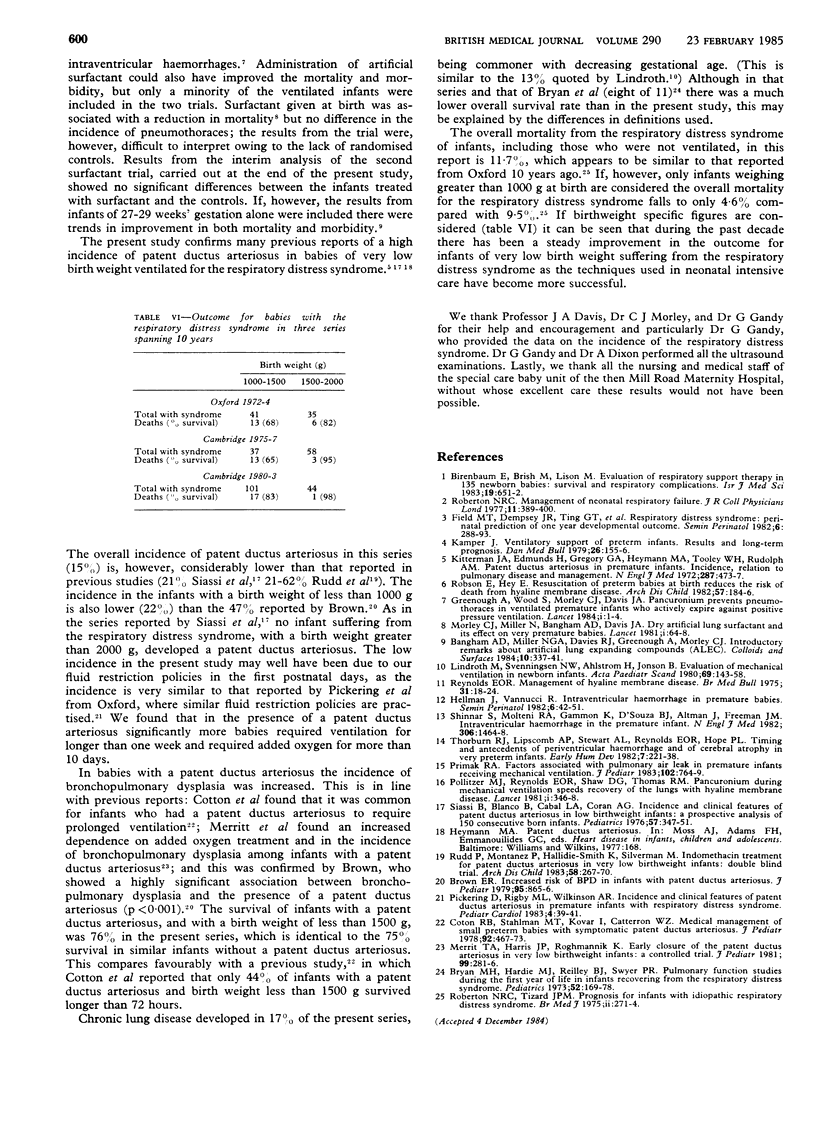Abstract
In a retrospective analysis the records of all (210) infants ventilated to treat the respiratory distress syndrome over three years were reviewed. A mortality of 19% was found. Intraventricular haemorrhage was associated than a significant increase in mortality in infants of less with 30 weeks' gestation (p less than 0.001) and was the commonest cause of death. Pneumothoraces developed in one third of babies regardless of gestational age but were significantly associated with an increase in mortality only in infants of 27-29 weeks' gestation. Patent ductus arteriosus was present in 31 infants and was commoner in babies of very low birth weight. The presence of a patent ductus arteriosus was not associated with decreased survival but was significantly related to an increased need for prolonged respiratory support (p less than 0.001). Thirty six infants developed chronic lung disease, three of whom died. Comparison with data from earlier studies indicated a steady improvement over the past decade in outcome for infants ventilated for the respiratory distress syndrome.
Full text
PDF



Selected References
These references are in PubMed. This may not be the complete list of references from this article.
- Birenbaum E., Lison M., Brish M. Evaluation of respiratory support therapy in 135 newborn infants: survival and respiratory complications. Isr J Med Sci. 1983 Jul;19(7):651–652. [PubMed] [Google Scholar]
- Brown E. R. Increased risk of bronchopulmonary dysplasia in infants with patent ductus arteriosus. J Pediatr. 1979 Nov;95(5 Pt 2):865–866. doi: 10.1016/s0022-3476(79)80454-0. [DOI] [PubMed] [Google Scholar]
- Bryan M. H., Hardie M. J., Reilly B. J., Swyer P. R. Pulmonary function studies during the first year of life in infants recovering from the respiratory distress syndrome. Pediatrics. 1973 Aug;52(2):169–178. [PubMed] [Google Scholar]
- Cotton R. B., Stahlman M. T., Kovar I., Catterton W. Z. Medical management of small preterm infants with symptomatic patent ductus arteriosus. J Pediatr. 1978 Mar;92(3):467–473. doi: 10.1016/s0022-3476(78)80451-x. [DOI] [PubMed] [Google Scholar]
- Field T. M., Dempsey J. R., Ting G. T., Hallock N., Dabiri C., Shuman H. H. Respiratory distress syndrome: perinatal prediction of one year development outcome. Semin Perinatol. 1982 Oct;6(4):288–293. [PubMed] [Google Scholar]
- Greenough A., Wood S., Morley C. J., Davis J. A. Pancuronium prevents pneumothoraces in ventilated premature babies who actively expire against positive pressure inflation. Lancet. 1984 Jan 7;1(8367):1–3. doi: 10.1016/s0140-6736(84)90177-6. [DOI] [PubMed] [Google Scholar]
- Hellmann J., Vannucci R. C. Intraventricular hemorrhage in premature infants. Semin Perinatol. 1982 Jan;6(1):42–53. [PubMed] [Google Scholar]
- Kamper J. Ventilatory support of pre-term infants--results and long-term prognosis. Dan Med Bull. 1979 May;26(3):155–156. [PubMed] [Google Scholar]
- Kitterman J. A., Edmunds L. H., Jr, Gregory G. A., Heymann M. A., Tooley W. H., Rudolph A. M. Patent ducts arteriosus in premature infants. Incidence, relation to pulmonary disease and management. N Engl J Med. 1972 Sep 7;287(10):473–477. doi: 10.1056/NEJM197209072871001. [DOI] [PubMed] [Google Scholar]
- Lindroth M., Svenningsen N. W., Ahlström H., Jonson B. Evaluation of mechanical ventilation in newborn infants. I. Techniques and survival rates. Acta Paediatr Scand. 1980 Mar;69(2):143–149. doi: 10.1111/j.1651-2227.1980.tb07051.x. [DOI] [PubMed] [Google Scholar]
- Merritt T. A., Harris J. P., Roghmann K., Wood B., Campanella V., Alexson C., Manning J., Shapiro D. L. Early closure of the patent ductus arteriosus in very low-birth-weight infants: a controlled trial. J Pediatr. 1981 Aug;99(2):281–286. doi: 10.1016/s0022-3476(81)80479-9. [DOI] [PubMed] [Google Scholar]
- Morley C. J., Bangham A. D., Miller N., Davis J. A. Dry artificial lung surfactant and its effect on very premature babies. Lancet. 1981 Jan 10;1(8211):64–68. doi: 10.1016/s0140-6736(81)90002-7. [DOI] [PubMed] [Google Scholar]
- Pollitzer M. J., Reynolds E. O., Shaw D. G., Thomas R. M. Pancuronium during mechanical ventilation speeds recovery of lungs of infants with hyaline membrane disease. Lancet. 1981 Feb 14;1(8216):346–348. doi: 10.1016/s0140-6736(81)91670-6. [DOI] [PubMed] [Google Scholar]
- Primhak R. A. Factors associated with pulmonary air leak in premature infants receiving mechanical ventilation. J Pediatr. 1983 May;102(5):764–768. doi: 10.1016/s0022-3476(83)80254-6. [DOI] [PubMed] [Google Scholar]
- Reynolds E. O. Management of hyaline membrane disease. Br Med Bull. 1975 Jan;31(1):18–24. doi: 10.1093/oxfordjournals.bmb.a071235. [DOI] [PubMed] [Google Scholar]
- Roberton N. R. Management of neonatal respiratory failure. J R Coll Physicians Lond. 1977 Jul;11(4):389–400. [PMC free article] [PubMed] [Google Scholar]
- Robson E., Hey E. Resuscitation of preterm babies at birth reduces the risk of death from hyaline membrane disease. Arch Dis Child. 1982 Mar;57(3):184–186. doi: 10.1136/adc.57.3.184. [DOI] [PMC free article] [PubMed] [Google Scholar]
- Rudd P., Montanez P., Hallidie-Smith K., Silverman M. Indomethacin treatment for patent ductus arteriosus in very low birthweight infants: double blind trial. Arch Dis Child. 1983 Apr;58(4):267–270. doi: 10.1136/adc.58.4.267. [DOI] [PMC free article] [PubMed] [Google Scholar]
- Shinnar S., Molteni R. A., Gammon K., D'Souza B. J., Altman J., Freeman J. M. Intraventricular hemorrhage in the premature infant. N Engl J Med. 1982 Jun 17;306(24):1464–1468. doi: 10.1056/NEJM198206173062406. [DOI] [PubMed] [Google Scholar]
- Siassi B., Blanco C., Cabal L. A., Coran A. G. Incidence and clinical features of patent ductus arteriosus in low-birthweight infants: a prospective analysis of 150 consecutively born infants. Pediatrics. 1976 Mar;57(3):347–351. [PubMed] [Google Scholar]
- Thorburn R. J., Lipscomb A. P., Stewart A. L., Reynolds E. O., Hope P. L. Timing and antecedents of periventricular haemorrhage and of cerebral atrophy in very preterm infants. Early Hum Dev. 1982 Dec 6;7(3):221–238. doi: 10.1016/0378-3782(82)90085-8. [DOI] [PubMed] [Google Scholar]


